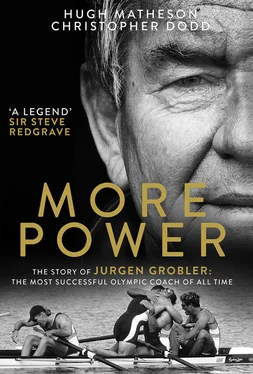Rowing made the cut, and fifty million East German marks (£12 million at 1977 rates) was pushed into the 1972 Olympiad. By then rowing was a reliable source of medals, and Grobler, aged 23 in 1969 when the Munich plans were laid, was still studying sports science at Leipzig. When he graduated in 1970, he went straight into a post as assistant coach in his hometown.
Dr Peter Schwanitz, who describes himself as a biomechanics specialist, came to know Grobler at that time in Berlin when Schwanitz was demonstrating boat testing at a training programme for elite coaches. Dr Theo Koerner, the head trainer of the East German rowing association DRSV, led the programme and promoted Grobler, enabling him and Sportclub Magdeburg to prosper.
Schwanitz says of Grobler today that he ‘was always very interested in the science of training’, science which encompassed all the specialisms that constitute a full understanding of how a human can move a boat over the required 2000 metres. Whenever a coach deconstructs a race, he or she will look at the split times for each quarter of the course and measure how these vary from perfectly even splits. In Munich, Hild’s race showed 102 seconds for the first 500, 109.7 seconds for the second, 114 seconds for the third and, in spite of the need for a final sprint, 115 seconds for the last 500. Alongside him, Wolfgang Güldenpfennig began more slowly at 103 seconds and gave away a further second (or one boat length in a single scull) to 1000 metres in under 111 seconds. He pulled all of Hild’s lead back to draw level at the 1500-metre mark in 112 seconds and left him wallowing in his wake in fourth place by covering the last 500 in fewer than 109 seconds.
Seen from the grandstand, Güldenpfennig held on to a place in the middle of the pack of scullers from the start and then sculled at a more even pace for the next three-quarters of the race, clocking successively 110, 112, 108.67 seconds for each 500 metres. Hild was quicker to the first and second marks before going progressively more slowly over the second half. While far from perfect, Güldenpfennig was demonstrating the superb endurance and racing nous that marked all the great East German crews of that era, and it was Grobler who had developed that ability in his 20-year-old club mate.
Hild’s race pattern of a quick first half followed by a slow second was standard practice for western nations, and even for other Eastern European states where full-time training should have resulted in greater endurance. The gold-medal winner in Munich, the Russian Yury Malyshev, took eleven seconds longer over the second half. The silver medallist Alberto Demiddi from Argentina was just over ten seconds slower and Hild, as we have seen, was seventeen seconds slower. Güldenpfennig dropped only 7.5 seconds.
Güldenpfennig’s preparation brought him far closer than everyone else to the even-paced splits ideal, and his trainer could claim some of the credit. However, the same pattern becomes evident when analysis is applied to all the East German medal-winning crews in Munich. The Germans were doing something consistently and well. The training programme designed by Dr Koerner was applied across all the performance centres. So Grobler would have started with a paper in his hand that told him exactly how much work was to be done, and at what pace, in each of thirteen sessions a week. The key was to equip him to test his charge on a daily basis to measure improvement and detect overtraining before it became apparent to anyone, including the athlete.
The East German trainers employed the ‘super-compensation cycle’, which is now universal. The athlete is pushed harder and harder for about six weeks of continuous training with no respite and builds up ‘residual fatigue’ so that the recovery between sessions is compromised. Then, when the bottom has been reached and the standard measures are well off the pace, the trainer’s foot is lifted from the pedal and light work is allowed for a number of days. The leap in recovery is marked by sharply improved measurements and, if the system is applied properly, the athlete soon rises above his previous best. Once the improvement is secured, the cycle is repeated with another sustained period of increasingly hard work until the bottom of the graph is reached again and the pressure is relieved to allow another rise, to a new peak.
Some of the East Germans were light years ahead of every other nation in the application of science to measure improvement and to detect decline in the performance of an individual in otherwise full health. This is the application of good science that Schwanitz recognised in Grobler. It was a safeguard against overtraining, and sometimes a complete collapse, that can result when a trainer uses unsophisticated measures to assess how deeply the hard work part of the cycle has bitten into the athlete’s performance, or if he is insensitive to a change in demeanour. Klaus Filter – who, as the leader of the team that developed the GDR fleet of competition boats, knew all the coaches – says that some of the Navy and Army coaches would measure only the number of strokes to the minute and number of kilometres covered to decide that the training had been successful. It was Grobler’s job to ensure that Magdeburg athletes were trained better and more wisely in order to beat the Navy and Army clubs by applying his sophisticated knowledge acquired at the university in Leipzig.
The other ingredient of training athletes better than any rivals was provision of support to enable them to accept the punishing regime. They were offered better accommodation in the high-performance centres than they would ever be likely to find at home. Their diet was enhanced well above the norm – the standard training of an international rower requires consumption of about 6500 calories a day for a man, in the proportion 50 per cent carbohydrates, 30 per cent fats and 20 per cent protein. These amounts were made available in SC Magdeburg, where Jürgen Grobler worked, by two club cooks with no one else to cater for.
Additionally, the scientists searched for any other medical cushion that would enable the bodies they trained to absorb more work without breaking down. In 1962 the East German state pharmacological research and development enterprise, Jenapharm, had isolated an anabolic steroid that it called Oral Turinabol. It was made available for therapeutic use in 1965. Within a year, testing for its effectiveness and for the appropriate dosage for athletes had begun. Once it was approved by the medical team it was made available to the coaches. It was the coaches’ decision, not the medical team’s, to use it to assist athletes. Men and, more controversially, women were dosed in time for the 1968 Olympics in Mexico City.
Oral Turinabol – a synthetic version of testosterone, the hormone that is known to increase muscle mass and bone density – was the ‘little blue pill’ on the breakfast tray of all East Germans training in sports that require either explosive or endurance strength. The athletes had to be seen to take the pill by the coach. The pills could not be taken home or even out of the room because of the secrecy surrounding the whole programme. The pills were described as ‘support’ and the athletes were not told of their content. Indeed, most experiments involved a control group that took a blue placebo.
Güldenpfennig was in the programme and his training intensity would have taken account of the assistance given by the drug. Grobler understood – better than many of his less curious colleagues – what was in the blue pill and will have measured its benefit and reported his findings to the medical commission, run directly by Manfred Ewald, through the Sport Medical Service and its deputy director and chief physician. At the Mexico Olympics in 1968 when Grobler was still studying in Leipzig, testing of competitors for illegal doping was rudimentary and the list of banned substances was short and unsophisticated. Few were discovered to be abusing performance drugs, but the divisions of opinion around the ethical questions posed by their use were becoming clear. The rights and wrongs of this matter were the subject of every coaching and training conference.
Читать дальше












